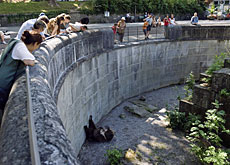
Bern’s bears set to get a new home

The Bern bears, a historic tourist attraction and symbol of the Swiss capital, are moving closer to gaining a new and more spacious home.
For years animal rights campaigners and visitors have been complaining about the small pits in which the bears are currently housed. The city now wants to move them to a specially made bear park.
Earlier this week the Bern cantonal parliament approved a credit of SFr2.75 million ($2.25 million) for the SFr9.7 million project.
The rest of the funding will come from sponsorship. On Wednesday the Bern tourism office announced that it had raised SFr237,650 for the bears from a sponsored run in the city, in which almost 1,000 people participated.
Sandra Schär, head of public relations at Bern Tourism, says the funding is well on target.
“It’s more or less financed at about 80 per cent, that means we are still looking for some money but we are sure that the project will be realised,” she told swissinfo.
The 6,500m² park will run from the site of the current bear pits to the River Aare. It will include a more bear-friendly habitat of meadows and trees and the animals will be able to fish in the river. It will be ten times larger than their current premises.
Schär says residents and visitors alike are looking forward to seeing the new park, which is scheduled to be ready in summer 2009.
“If you go on a sunny day in spring or summertime to the bear pits you see a lot of people, guests from abroad and Switzerland, but Bernese people as well, families coming with their children,” explained Schär.
“It’s no longer time for the pits, the bears have to be in a park and have access to the Aare [where] they can swim, hunt and play together.”
Bearing on history
Bears have a long association with Bern. It is said that the founder of Bern, Berchtold V von Zähringen, killed a bear on the Aare peninsula and this led to the town being called Bern (from the German Bär) and explains why the city’s coat of arms features a bear.
The animals have been kept in the city for almost 500 years, but have been in their existing location since 1857. At that time more than 12 bears were kept in a 3.5 metre-deep pit as a symbol of victory and of man’s power over animals.
Around ten years ago the pits underwent some renovation to provide the bears with a more suitable habitat and the tourists with a better view of their furry friends.
But complaints about their present home have continued. Animal rights activists have pointed to the lack of natural environment, while tourists are often critical of the small enclosure in which the bears are kept.
The bear park project was put forward in 2003. The enclosure will allow the bears to be outside 24 hours a day – which is very important for the animals.
Visitors will be able to gain a good insight into bear life from the paths running around the enclosure and cameras and sensors will help locate the animals.
The park is not just aimed at giving a boost to tourism, the organisers are keen to stress that Bern residents will also be gaining a leisure area as well.
Pedro and Tana
It is hoped that the current two pit residents, Pedro and Tana, who originally came from a zoo in Barcelona in Spain, will be the first residents of the new park. The two Pyrenean brown bears, siblings, are now 26 years old.
A third bear, Urs, died earlier this month at the grand old bear age of 30.
But Bern’s citizens still have to approve a change of zone in the city to allow the park to be built.
Schär is, however, confident that the park will open to the public on time, especially given its importance to the city.
“The bear is important for the city of Bern, it gave it its name and we are used to having the bears here. It would really be a loss if we didn’t have the bears.”
swissinfo, Isobel Leybold-Johnson
There are currently two bears, the siblings Pedro and Tana, in the bear pit.
They are Pyrenean brown bears, originally from Spain. They were born in 1981.
There are an estimated 50,000 brown bears in Europe.
Male brown bears can grow to 350kg, females to 200kg.
One of the bears, Urs, died earlier this month at the grand old age of 30. His remains have been sent to the town of Solothurn.
Since 1925 Solothurn has had its own bear in the Bern bear pits in memory of sculptor Urs Eggenschwyler. The artist used to own bears at his private zoo and left one, Urs, to Solothurn in his will which the town authorities sent to Bern.
Solothurn decided it would continue to provide a bear – always named Urs – to Bern. The bear’s remains are sent back to the town after it dies.
The arrangement lapsed for a while and was revived in 1978. It involved renaming a bear – the latest Urs was originally called Freddy.

In compliance with the JTI standards
More: SWI swissinfo.ch certified by the Journalism Trust Initiative
















![The four-metre-long painting "Sonntag der Bergbauern" [Sunday of the Mountain Farmers, 1923-24/26] had to be removed by a crane from the German Chancellery in Berlin for the exhibition in Bern.](https://www.swissinfo.ch/content/wp-content/uploads/sites/13/2025/12/01_Pressebild_KirchnerxKirchner.jpg?ver=a45b19f3)












You can find an overview of ongoing debates with our journalists here . Please join us!
If you want to start a conversation about a topic raised in this article or want to report factual errors, email us at english@swissinfo.ch.